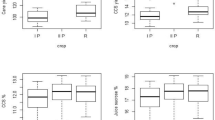Abstract
High cane yield and commercially extractable sucrose (CCS) content are two of the key sugarcane commercial traits selected in sugarcane breeding programs. Advancements in genomic prediction may provide opportunities to speed up gains for these traits in breeding programs by combining accurate prediction of breeding values in candidate parent clones shortening generation intervals. Selection trials in commercial breeding programs may provide training populations for developing genomic predictions. In this study, three different populations of clones in early and advanced stage selection trials in an established commercial sugarcane breeding program were used to assess genomic prediction accuracy. The clones (genotypes) were evaluated for cane yield and sugar content in field trials and genotyped using a SNP array developed for sugarcane cultivars and parents. Five models (Bayes A, Bayes B, Bayesian LASSO, Bayesian GBLUP and RKHS) were tested using pedigree and/or marker data. Prediction models that included marker information had higher prediction accuracies than models with pedigree data only. For CCS, the prediction accuracies for genotypes in advanced stage trials using DNA markers were superior compared with prediction accuracies for early-stage trials, suggesting that prior intensive selection for CCS did not diminish accuracy of genomic prediction. However, by contrast, for cane yield, the prediction accuracies were much less for the population in the advanced stages of selection. The levels of prediction accuracy obtained in most datasets (0.25–0.45) are encouraging for developing applications of genomic prediction to predict breeding values of yield and sugar content in sugarcane breeding programs.



Similar content being viewed by others
References
Aitken K, Farmer A, Berkman P, Muller C, Wei X, Demano E, Jackson P, Magwire M, Dietrich B, Kota R (2016) Generation of a 345K sugarcane SNP chip. Proc Aust Soc Sugar Cane Technol:1165–1172
Arceneaux G (1967) Cultivated sugarcanes of the world and their botanical derivation. Proc Int Soc Sugar Cane Technol:844–854
Berding N, Marston DH (2010) Operational validation of the efficacy of SpectraCane™, a high-spped analytical system for sugarcane qulaity components. Proc Int Soc Sugar Cane Technol 32:445–459
BSES (1984) The standard laboratory manual for Australian sugar Mills. Bureau of Sugar Experiment Stations, Brisbane
Butler DG, Cullis BR, Gilmour AR, Gogel BJ (2009) Mixed models for S language environments ASReml-R reference manual. The Department of Primary Industres and Fisheries. Queensland Government, Australia
Crossa J, de los Campos G, Pérez P (2010) Prediction of genetic values of quantitative traits in plant breeding using pedigree and molecular markers. Genetics 186:713–724
Crossa J, Pérez P, de los Campos G, Mahuku G, Dreisigacker S, Magorokosho C (2011) Genomic selection and prediction in plant breeding. J Crop Improv 25:239–261
Crossa J, Beyene Y, Kassa S, Pérez P, Hickey JM, Chen C, de los Campos G, Burgueño J, Windhausen VS, Buckler E (2013) Genomic prediction in maize breeding populations with genotyping-by-sequencing. G3 Genes Genomes Genetics 3:1903–1926
Crossa J, Perez P, Hickey J, Burgueno J, Ornella L, Cerón-Rojas J, Zhang X, Dreisigacker S, Babu R, Li Y (2014) Genomic prediction in CIMMYT maize and wheat breeding programs. Heredity 112:48
Cullis B, Smith A, Coombes N (2006) On the design of early generation variety trials. J Agric Biol Environ Stat 11:381–393
Daniels J, Roach BT (1987) Taxonomy and evolution. Sugarcane improvement through breeding, vol 7. Elsevier, Amsterdam, pp 7–84
de los Campos G, Gianola D, Rosa GJ, Weigel KA, Crossa J (2010) Semi-parametric genomic-enabled prediction of genetic values using reproducing kernel Hilbert spaces methods. Genet Res 92(4):295–308
Falconer DS and Mackey TFC (1996) Introduction to quantitative genetics, 4th ed. Longman, Burnt Mill, England
Garcia AAF, Mollinari M, Marconi TG, Serang OR, Silva RR, Vieira MLC, Vicentini R, Costa EA, Mancini MC, Garcia MOS, Pastina MM, Gazaffi R, Martins ERF, Dahmer N, Sforça DA, Silva CBC, Bundock P, Henry RJ, Souza GM, van Sluys MA, Landell MGA, Carneiro MS, Vincentz MAG, Pinto LR, Vencovsky R, Souza AP (2013) SNP genotyping allows an in-depth characterisation of the genome of sugarcane and other complex autopolyploids. Sci Rep 3:3399. https://doi.org/10.1038/srep03399
Gerard D, Ferrão LFV, Garcia AAF, Stephens M (2018) Genotyping polyploids from messy sequencing data. Genetics 210(3):789–807. https://doi.org/10.1534/genetics.118.301468
González-Camacho JM, de los Campos G, Pérez-Rodríguez P, Gianola D, Cairns JE, Mahuku G, Babu R, Crossa J (2012) Genome-enabled prediction of genetic values using radial basis function. Theor Appl Genet 125:759–771
Gouy M, Rousselle Y, Bastianelli D, Lecomte P, Bonnal L, Roques D, Efile JC, Rocher S, Daugrois J, Toubi L, Nabeneza S, Hervouet C, Telismart H, Denis M, Thong-Chane A, Glaszmann JC, Hoarau JY, Nibouche S, Costet L (2013) Experimental assessment of the accuracy of genomic selection in sugarcane. Theor Appl Genet 126:2575–2586
Hayes BJ, Bowman PJ, Chamberlain A, Goddard M (2009a) Invited review: genomic selection in dairy cattle: Progress and challenges. J Dairy Sci 92:433–443
Hayes BJ, Bowman PJ, Chamberlain AC, Verbyla K, Goddard ME (2009b) Accuracy of genomic breeding values in multi-breed dairy cattle populations. Genet Sel Evol 41:51
Heffner EL, Sorrells ME, Jannink J-L (2009) Genomic selection for crop improvement. Crop Sci 49:1–12
Heffner EL, Jannink J-L, Iwata H, Souza E, Sorrells ME (2011) Genomic selection accuracy for grain quality traits in biparental wheat populations. Crop Sci 51:2597–2606
Heinz DJ (1987) Sugarcane improvement through breeding. Elsevier
Jackson P (2018) Advances in conventional sugarcane breeding. In: Rott P (ed) Achieving sustainable cultivation of sugarcane volume 2: breeding, pests and diseases. Burleigh Dodds Science Publishing, Cambridge
Jackson P, McRae T (2001) Selection of sugarcane clones in small plots. Crop Sci 41:315–322
Jannoo N, Grivet L, Seguin M, Paulet F, Domaingue R, Rao P, Dookun A, d’Hont A, Glaszmann J (1999) Molecular investigation of the genetic base of sugarcane cultivars. Theor Appl Genet 99:171–184
Jarquín D, Lemes da Silva C, Gaynor RC, Poland J, Fritz A, Howard R, Battenfield S, Crossa J (2017) Increasing genomic-enabled prediction accuracy by modeling genotype by environment interactions in Kansas wheat. Plant Genome 10. https://doi.org/10.3835/plantgenome2016.12.0130
Matei G, Woyann LG, Milioli AS, de Bem Oliveira I, Zdziarski AD, Zanella R, Coelho ASG, Finatto T, Benin G (2018) Genomic selection in soybean: accuracy and time gain in relation to phenotypic selection. Mol Breed 38:117
Meuwissen T, Hayes B, Goddard M (2001) Prediction of total genetic value using genome-wide dense marker maps. Genetics 157:1819–1829
Mollinari M, Garcia AAF (2019) Linkage analysis and haplotype phasing in experimental autopolyploid populations with high ploidy level using hidden Markov models. G3 Genes Genomes Genetics 9(10):3297–3314. https://doi.org/10.1534/g3.119.400378
Pérez P, de los Campos G (2014) Genome-wide regression & prediction with the BGLR statistical package. Genetics 114:164442
Pérez-Rodríguez P, Gianola D, González-Camacho JM, Crossa J, Manès Y, Dreisigacker S (2012) Comparison between linear and non-parametric regression models for genome-enabled prediction in wheat. G3: Genes, Genomes, Genetics 2:1595–1605
Poland J (2015) Breeding-assisted genomics. Curr Opin Plant Biol 24:119–124
Raboin L-M, Pauquet J, Butterfield M, D’Hont A, Glaszmann J-C (2008) Analysis of genome-wide linkage disequilibrium in the highly polyploid sugarcane. Theor Appl Genet 116:701–714
Rattey A, Jackson P, Wei X, Cox M, Stringer J (2004) Opportunities to increase rates of parent improvement in Australian sugarcane breeding programs. In: Proceedings—Australian Society of Sugar Cane Technologists. PK Editorial Services, pp 42–42
Roach B (1989) Origin and improvement of the genetic base of sugarcane. Proc Aust Soc Sugar Cane Technol:34–47
Rutkoski J, Singh R, Huerta-Espino J, Bhavani S, Poland J, Jannink J, Sorrells M (2015) Efficient use of historical data for genomic selection: a case study of stem rust resistance in wheat. The Plant Genome 8
Schmitz Carley CA, Coombs JJ, Douches DS, Bethke PC, Palta JP, Novy RG, Endelman JB (2017) Automated tetraploid genotype calling by hierarchical clustering. Theor Appl Genet 130:717–726. https://doi.org/10.1007/s00122-016-2845-5
Serang O, Mollinari M, Garcia AAF (2012) Efficient exact maximum a posteriori computation for Bayesian SNP genotyping in polyploids. PLoS One 7(2):e30906. https://doi.org/10.1371/journal.pone.0030906
Sinnwell JP, Therneau TM, Schaid DJ (2014) The kinship2 R package for pedigree data. Hum Hered 78:91–93
Smith AB, Stringer J, Wei X, Cullis BR (2007) Varietal selection for perennial crops where data relate to multiple harvests from a series of field trials. Euphytica 157:253–266
Stringer J, Cullis B, Thompson R (2011) Joint modeling of spatial variability and within-row interplot competition to increase the efficiency of plant improvement. J Agric Biol Environ Stat:1–13
Tusell L, Pérez-Rodríguez P, Forni S, Gianola D (2014) Model averaging for genome-enabled prediction with reproducing kernel Hilbert spaces: a case study with pig litter size and wheat yield. J Anim Breed Genet 131(2):105–115
Van Grevenhof IE, Van Der Werf JH (2015) Design of reference populations for genomic selection in crossbreeding programs. Genet Sel Evol 47:14
Vélez-Torres M, García-Zavala JJ, Hernández-Rodríguez M, Lobato-Ortiz R, López-Reynoso JJ, Benítez-Riquelme I, Mejía-Contreras JA, Esquivel-Esquivel G, Molina-Galán JD, Pérez-Rodríguez P (2018) Genomic prediction of the general combining ability of maize lines (Zea mays L.) and the performance of their single crosses. Plant Breed 137:379–387
Wei X, Jackson P (2017) Addressing slow rates of long-term genetic gain in sugarcane. Int Sugar J 119:480–484
Wei X, Jackson PA, Hermann S, Kilian A, Heller-Uszynska K, Deomano E (2010) Simultaneously accounting for population structure, genotype by environment interaction, and spatial variation in marker-trait associations in sugarcane this article is one of a selection of papers from the conference “exploiting genome-wide association in oilseed brassicas: a model for genetic improvement of major OECD crops for sustainable farming”. Genome 53:973–981
You FM, Booker HM, Duguid SD, Jia G, Cloutier S (2016) Accuracy of genomic selection in biparental populations of flax (Linum usitatissimum L.). Crop J 4:290–303
You Q, Yang X-P, Peng Z, Xu L-P, Wang J-P (2018) Development and applications of a high throughput genotyping tool for polyploid crops: single nucleotide polymorphism (SNP) array. Front Plant Sci 9. https://doi.org/10.3389/fpls.2018.00104
Author contribution statement
XW and PJ initiated the study and coordinated collection of phenotypic data. XW conducted analyses of phenotypic data. KA and RK coordinated development of the SNP array and collation of DNA marker data. ED conducted all analyses related to genomic prediction. PPR assisted in the development of R scripts for fitting Bayesian models. ED, PJ and XW wrote the manuscript, and all authors read the manuscript.
Funding
Financial support for the research reported on here, including the collection of the large datasets, was provided by Sugar Research Australia, Syngenta and Commonwealth Scientific and Industrial Research Organisation. A large number of staff from breeding programs operated Sugar Research Australia and Wilmar Sugar Australia contributed to collecting phenotypic data from field trials, and we are grateful for their competent conduct of these trials.
Author information
Authors and Affiliations
Corresponding author
Ethics declarations
Conflict of interest
The authors declare that they have no conflict of interest.
Additional information
Publisher’s note
Springer Nature remains neutral with regard to jurisdictional claims in published maps and institutional affiliations.
Key message
• Genomic prediction of cane yield and sugar content in populations of sugarcane in early and advanced stages of selection using a range of models provide encouraging levels of accuracies for developing practical applications in sugarcane breeding.
Rights and permissions
About this article
Cite this article
Deomano, E., Jackson, P., Wei, X. et al. Genomic prediction of sugar content and cane yield in sugar cane clones in different stages of selection in a breeding program, with and without pedigree information. Mol Breeding 40, 38 (2020). https://doi.org/10.1007/s11032-020-01120-0
Received:
Accepted:
Published:
DOI: https://doi.org/10.1007/s11032-020-01120-0




